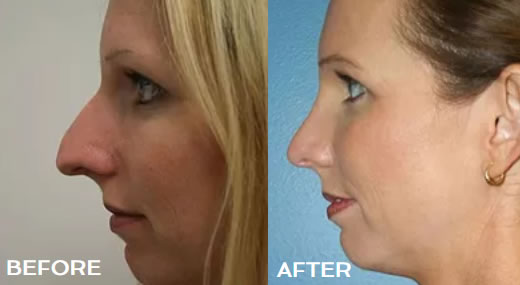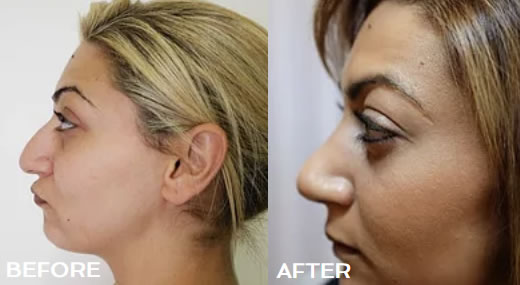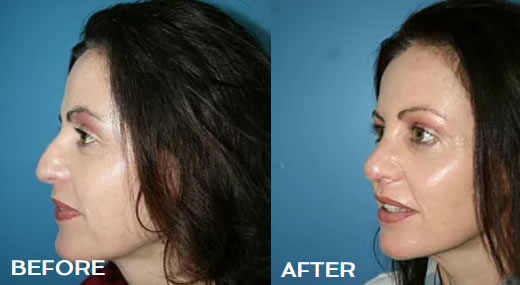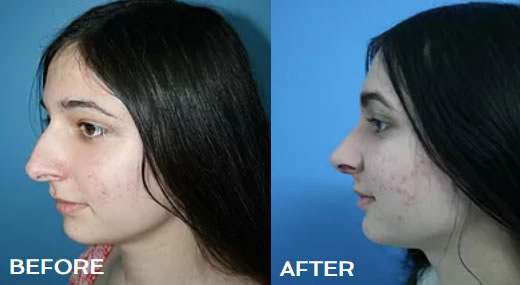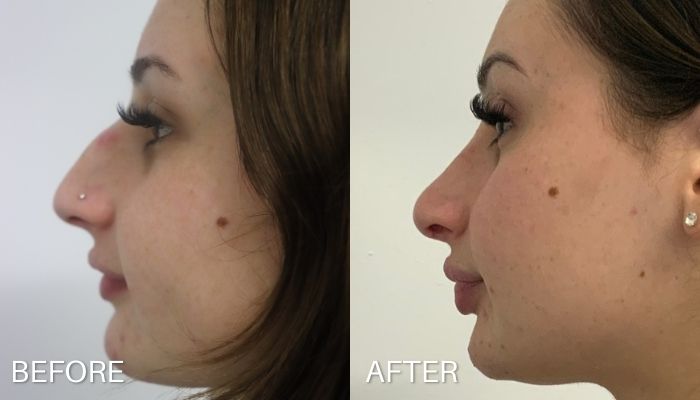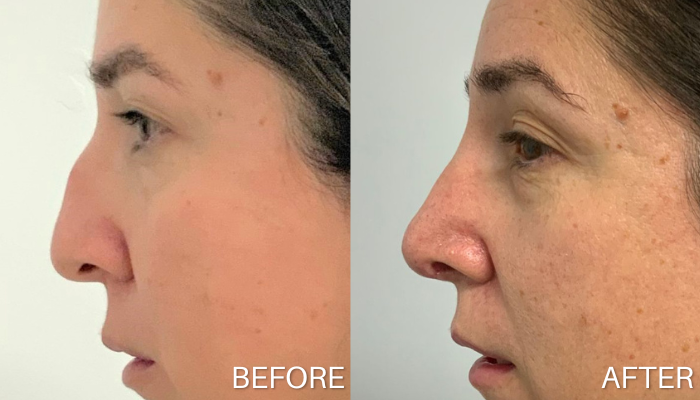If you are unhappy with the shape, size or proportion of your nose, rhinoplasty (commonly known as a Nose Job) may offer the improvement you seek.
As the only surgeon in Australia specialising in both Maxillofacial and Cosmetic Surgery, Dr John McHugh is uniquely qualified to deliver an aesthetically beautiful result.
View our Frequently Asked Questions below to find out more about Rhinoplasty.
Frequently Asked Questions
Rhinoplasty (or a nose job as they are often called) offers benefits to individuals of almost any age. However, children and teens should wait until their facial growth is complete. For girls this typically occurs between at age 16 and for boys at age 18. Teens should only undergo rhinoplasty if it is their own idea.
Good candidates for a rhinoplasty include healthy individuals with any of the following issues:
– Nose disproportionately large for the face
– Hump or depression on the nasal bridge
– Disproportionately wide shape
– Nasal tip that droops
– Enlarged nasal tip
– Excessively flared nostrils
– Off-centre or crooked nose
– Asymmetry caused by injury
– Airway obstruction impairing breathing
A personal consultation with your surgeon is the first step for any patient considering rhinoplasty. Dr McHugh will assess your physical and emotional health, discuss your aesthetic goals, and address any questions or concerns you may have.
Issues you should be prepared to discuss during consultation with Dr McHugh include:
– Medical conditions, both past and present
– Current medications, including nutritional supplements and herbal remedies
– Past surgeries
– Allergies causing congestion or breathing difficulties
– Nasal spray use
Your physical evaluation will include an assessment of your nasal structure, skin tone, and the current shape and size of your nose. Dr McHugh will also carefully evaluate the relationship of your nose with your other features to create the balance needed for optimal results.
For some, Dr McHugh may discuss additional procedures to enhance physical appearance or improve breathing after rhinoplasty. Patients frequently combine chin implant surgery with their procedure, to improve facial harmony and make add strength to their jawline. For breathing issues, a turbinoplasty is often performed to open nasal passages. A septoplasty can also be performed with a rhinoplasty to correct a deviated septum.
There are many variations to the rhinoplasty procedure. The technique Dr McHugh uses for you depends upon your individual features and aesthetic goals. Alterations can be made to change your nose angle, reshape the tip, narrow the nostrils or change the size or width of the nasal bridge. Dr McHugh will discuss your options with you during your consultation.
Rhinoplasty allows the bone and cartilage of the nose to be sculpted as desired. Depending upon your needs, Dr McHugh may reposition or reshape the nasal bones. If needed, certain areas may be built up using cartilage or bone from the nose, or cartilage from other areas of the body, usually the septum of the nose.
After the underlying structure of the nose is reshaped, the skin and soft tissues are redraped over the reshaped framework. In some instances, such as with nostril reduction, a small bit of skin at the base of the nostrils may be removed. The incisions from this are concealed in the nose’s natural creases, although this is rarely necessary.
Though thousands of people undergo this procedure each year and experience no major complications, the procedure does carry some degree of risk. It is important you be well informed of these risks when considering a rhinoplasty.
The discussion of potential risks and complications is one of the most important aspects of patient consultation. During your consultation, Dr McHugh will discuss these potential complications with you, listen to your safety questions, and offer recommendations on how to minimise your risk.
It is important to follow Dr McHugh’s instructions when preparing for surgery to ensure the best possible results. Those instructions may include:
– Refraining from smoking for several weeks before and after surgery
– Avoiding certain medications
– Arranging for help following surgery, such as a ride home and in-home care for the first 24 hours
For your comfort and convenience, Dr McHugh operates either in his clinic under local anaesthetic with intravenous sedation or under general anaesthetic at various private hospitals.
He will carefully monitor your physical status throughout the operation and during your recovery.
Directly after surgery, you’ll be taken to a recovery area. Your head will be elevated and any pain you may feel will be controlled with medication. In most instances, a splint will be applied to the bridge of the nose for stabilisation purposes. Splints may also be used inside the nostrils, especially if work has been done to improve breathing. A small bandage beneath the nose tip will also be applied in cases of open rhinoplasty.
Though everyone heals at a different pace, the following is typical of recovery from a brow lift:
The day of rhinoplasty surgery
– In this early stage of healing, activity must be kept to a minimum
– Resting with your head elevated is important to minimize swelling
– Bleeding and stuffiness may occur in small amounts
Within 10 days
– Bruising will begin to subside
– Swelling reaches its peak and then begins to go down
– Stitches and splints will be removed
– Makeup can be applied to conceal any discoloration
– Non-strenuous activity may begin
After several weeks
– Exercise and most other normal activities may resume
– Most swelling will subside
– Numbness will diminish; though some may persist for several months
– Eyeglasses may be worn
It will be important to keep your nose shielded from sunlight for several months. Using sunblock to protect your skin is essential.
Your results should begin to emerge within a few weeks after surgery. As each month passes, you’ll notice gradual improvement until healing is complete. It may take up to two years or more for your final results to appear.
Though getting used to your new look may take time, most patients are very pleased with their results. Rhinoplasty results are permanent, though the ageing process may eventually change your nose shape.
Follow-up visits are important to answer any questions you may have and monitor your healing process.
Your first post-operative visit will be scheduled after the initial healing period, during the first few days after surgery.
In the following months, Dr McHugh may ask you to return for periodic checkups.
Keeping these appointments is important to assessing your long-term results and address any questions or concerns you may have.
Rhinoplasty Gallery
Before-and-after photos of rhinoplasties (‘nose jobs’) performed by Dr McHugh

His dual specialisations enable him to deliver excellence in surgical results, with an eye for aesthetic beauty.
With over 20 years of experience as a surgeon in the private sector and performing international aid work as a Surgeon Commander with the Royal Australian Navy, you can have confidence that Dr McHugh is uniquely qualified and trusted to deliver the results you seek.


